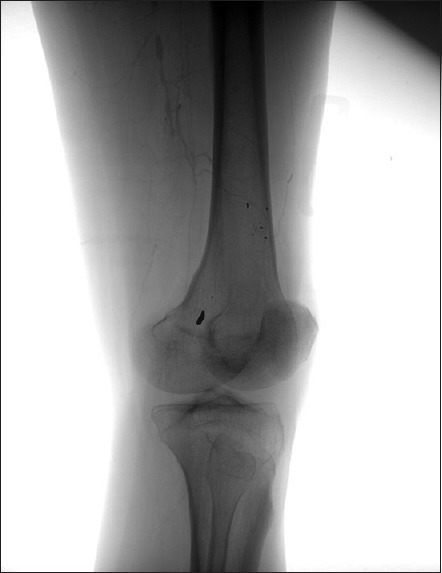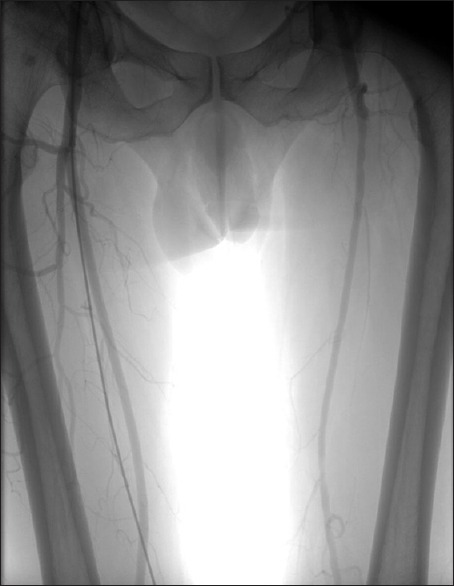Abstract
After cisplatin and bleomycin-containing chemotherapy (CTx) for testicular cancer, part of the patients may develop acute or long-term cardiovascular toxicity. In the present case, we reported that a 58-year-old male patient presenting with testicular tumors who developed acute peripheral arterial disease during combination CTx with bleomycin, etoposide, and cisplatin. Superficial femoral artery occlusion not responded to structure thrombolytic and anticoagulators treatment. Left lower extremity was amputated below knee. In patients with high risk of cardiovascular disease, prophylactic anticoagulation may be recommended. The risk of causing factors of thromboembolism in patients with testicular cancer under cisplatin and bleomycin-containing CTx should be evaluated.
Key Words: Chemotherapy, testicular neoplasm, thromboembolism
INTRODUCTION
Three-drug combination chemotherapy (CTx) for testicular tumors (bleomycin, etoposide, and cisplatin [BEP] therapy) is performed as standard treatment in many hospitals. The side effects of anticancer drugs include vascular toxicity.[1] In this report, we present a patient with testicular tumors who developed acute peripheral arterial disease during combination CTx.
CASE REPORT
A 58-year-old male patient presented with a mixed germ cell neoplasm (GCN) (seminoma and yolk sac tumor). Postoperative BEP treatment was started. The patient did not have a history of vascular diseases. No sign or symptoms related with vascular diseases at the initial visit. After 1st cycle of BEP, bilateral lower extremities (LE) were mildly cyanotic, cold, and hyperemic. Circulations of both LE were normal in Doppler ultrasound (US). Raynaud's syndrome was diagnosed and calcium channel blocker diltiazem 30 mg started. After 2nd cycle of BEP, the main complaints were severe pain and coldness on the bilateral LE. A Doppler US showed acute bilateral popliteal artery thrombosis. Bilateral popliteal arterial embolectomy was performed, and LE reperfusions have been completely restored [Figure 1]. Low molecular weight heparin (LMWH) prophylaxis started. Our patient has cardiovascular disease (CVD) risk factors such as smoking, hyperlipidemia, hypertension, and diabetes mellitus. A coronary angiography was normal. In follow-up, LE circulations were normal before and after 3rd cycle of BEP CTx under LMWH medication. LMWH was stopped the 4th cycle of BEP CTx was administered by a different medical center. Patient presented to our center with acute left LE ischemia and pain. Superficial femoral artery occlusion was detected in peripheral angiography. Depending on late ischemia, superficial femoral arterial occlusion, poor distal artery structure thrombolytic, and anti-coagulators treatment was started [Figure 2]. Patient did not respond to medical treatment. Left LE was amputated below the knee.
Figure 1.

Peripheral angiography; after popliteal arterial embolectomy
Figure 2.

Peripheral angiography; superficial femoral arterial occlusion
DISCUSSION
Testicular germ cell cancer is the most common malignancy in men between 20 and 40 years of age. Approximately, half of these germ cell tumors are nonseminomas. Nonseminomas are disseminated in approximately 50% of the patients at presentation. After an orchidectomy, standard treatment of disseminated nonseminoma consists of CTx with a combination of BEP.[2]
Cisplatin- and bleomycin-containing CTx for testicular cancer has been associated with both acute and long-term vascular toxicity. Endothelial injury has been described after the administration of cisplatin and bleomycin in vitro.[3] Raynaud's phenomenon, believed to be a vascular toxic effect of bleomycin, has been reported in up to 37% of patients.[4] Several patients have also been reported in whom myocardial infarction occurred during or shortly after the administration of cisplatin.[5] Furthermore, long-term survivors of disseminated testicular cancer have an increased risk for CVD.[6]
In vitro endothelial injury has been shown by cisplatin (CP) and bleomycin.[7] When cisplatinum added to vinblastine and bleomycin combination Raynaud's syndrome was observed in 41% of patients. These findings support the endothelial injury and vasospasm in the pathogenesis.[8] Cardiac risk factors such as hypercholesterolemia, dyslipidemia, and hypertension are more common in patient (ptx) treated with CTx in testicular cancer.[9] Cheng et al. had reported arterial thrombosis in metastatic testicular germ cell tumors in two patients. In this study, they reported that there is no recommendation for thromboembolic event prophylaxis in oncological guidelines.[10]
Physicians should be careful regarding cardiovascular symptoms in a patient treated with CP. Any new onset of cardiovascular symptoms, extremity pallor, paresthesia, pain, and pulselessness is taken into account. Although it is not presented in the guidelines, ptx may be evaluated for CVD. Angiographic evaluation may be performed in patients with the presence of atherosclerosis. In patients with high risk of CVD prophylactic anti-coagulation may be recommended. Further prospective studies are needed to evaluate the risk of causing factors of thromboembolism in patients with GCN.
Financial support and sponsorship
Nil.
Conflicts of interest
There are no conflicts of interest.
REFERENCES
- 1.Strumberg D, Brügge S, Korn MW, Koeppen S, Ranft J, Scheiber G, et al. Evaluation of long-term toxicity in patients after cisplatin-based chemotherapy for non-seminomatous testicular cancer. Ann Oncol. 2002;13:229–36. doi: 10.1093/annonc/mdf058. [DOI] [PubMed] [Google Scholar]
- 2.International Germ Cell Consensus Classification: A prognostic factor-based staging system for metastatic germ cell cancers. International Germ Cell Cancer Collaborative Group. J Clin Oncol. 1997;15:594–603. doi: 10.1200/JCO.1997.15.2.594. [DOI] [PubMed] [Google Scholar]
- 3.Ito H, Okafuji T, Suzuki T. Vitamin E prevents endothelial injury associated with cisplatin injection into the superior mesenteric artery of rats. Heart Vessels. 1995;10:178–84. doi: 10.1007/BF01744983. [DOI] [PubMed] [Google Scholar]
- 4.Bokemeyer C, Berger CC, Kuczyk MA, Schmoll HJ. Evaluation of long-term toxicity after chemotherapy for testicular cancer. J Clin Oncol. 1996;14:2923–32. doi: 10.1200/JCO.1996.14.11.2923. [DOI] [PubMed] [Google Scholar]
- 5.Weijl NI, Rutten MF, Zwinderman AH, Keizer HJ, Nooy MA, Rosendaal FR, et al. Thromboembolic events during chemotherapy for germ cell cancer: A cohort study and review of the literature. J Clin Oncol. 2000;18:2169–78. doi: 10.1200/JCO.2000.18.10.2169. [DOI] [PubMed] [Google Scholar]
- 6.Fosså SD, Aass N, Harvei S, Tretli S. Increased mortality rates in young and middle-aged patients with malignant germ cell tumours. Br J Cancer. 2004;90:607–12. doi: 10.1038/sj.bjc.6601558. [DOI] [PMC free article] [PubMed] [Google Scholar]
- 7.Kohli S, Kohli M. Acute chemotherapy-induced cardiovascular changes in patients with testicular cancer: Are there implications for blood pressure management in patients receiving chemotherapy? J Clin Oncol. 2006;24:2399. doi: 10.1200/JCO.2006.05.7836. [DOI] [PubMed] [Google Scholar]
- 8.Vogelzang NJ, Bosl GJ, Johnson K, Kennedy BJ. Raynaud's phenomenon: A common toxicity after combination chemotherapy for testicular cancer. Ann Intern Med. 1981;95:288–92. doi: 10.7326/0003-4819-95-3-288. [DOI] [PubMed] [Google Scholar]
- 9.Gietema JA, Sleijfer DT, Willemse PH, Schraffordt Koops H, van Ittersum E, Verschuren WM, et al. Long-term follow-up of cardiovascular risk factors in patients given chemotherapy for disseminated nonseminomatous testicular cancer. Ann Intern Med. 1992;116:709–15. doi: 10.7326/0003-4819-116-9-709. [DOI] [PubMed] [Google Scholar]
- 10.Cheng E, Berthold DR, Moore MJ, Duran I. Arterial thrombosis after cisplatin-based chemotherapy for metastatic germ cell tumors. Acta Oncol. 2009;48:475–7. doi: 10.1080/02841860802446779. [DOI] [PubMed] [Google Scholar]


